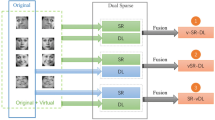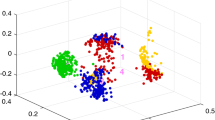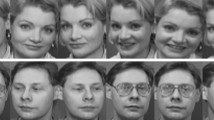Abstract
Image classification is a hot technique applied in many multimedia systems, where both l1 and l2 regularizations have shown potential for robust sparse representation-based image classification. However, previous studies showed that l1 or l2 alone cannot ensure a robust result. The robustness of a classifier depends on the nature of the dataset most of the time. What is worse, data augmentation may make the dataset more complicated, which leads a sparse model become harder to optimize. In this paper, a novel sparse representation that learns double weights through data augmentation is proposed for robust image classification. The first weight combines the two coefficients solved by l1 and l2 regularizations to obtain a more discriminative representation, while the second weight integrates the residuals obtained from the original and virtual samples, to take full advantage of diversity created by data augmentation. The double-weight process builds a robust model that is able to deal with the augmented but variational datasets. Experiments on popular facial and object datasets demonstrate the promising performance of the proposed method. Learning double weights via sample virtualization is helpful to develop multimedia applications.










Similar content being viewed by others
References
Akhtar N, Shafait F, Mian A (2017) Efficient classification with sparsity augmented collaborative representation. Pattern Recogn 65:136–145
Beck A, Teboulle M (2009) A fast iterative shrinkage-thresholding algorithm for linear inverse problems. SIAM Journal on Imaging Sciences 2(1):183–202
Bloice MD, Holzinger A (2019) Patch augmentation: towards efficient decision boundaries for neural networks. arXiv:1911.07922
Bloice MD, Roth PM, Holzinger A (2019) Biomedical image augmentation using augmentor. Bioinformatics 35(21):4522–4524
Bloice MD, Stocker C, Holzinger A (2017) Augmentor: an image augmentation library for machine learning. arXiv:1708.04680
Cai S, Zhang L, Zuo W, Feng X (2016) A probabilistic collaborative representation based approach for pattern classification. In: Proceedings of the IEEE conference on computer vision and pattern recognition, pp 2950–2959
Chen L, Man H, Nefian AV (2005) Face recognition based on multi-class mapping of fisher scores. Pattern Recogn 38(6):799–811
Crispell D, Biris O, Crosswhite N, Byrne J, Mundy JL (2017) Dataset augmentation for pose and lighting invariant face recognition. arXiv:1704.04326
Florea MI, Vorobyov SA (2017) A robust fista-like algorithm. In: 2017 IEEE international conference on acoustics, speech and signal processing (ICASSP). IEEE, pp 4521–4525
Gao Y, Ma J, Yuille AL (2017) Semi-supervised sparse representation based classification for face recognition with insufficient labeled samples. IEEE Trans Image Process 26(5):2545–2560
Guo G, Li SZ, Chan KL (2001) Support vector machines for face recognition. Image Vision Comput 19(9-10):631–638
Han D, Liu Q, Fan W (2018) A new image classification method using cnn transfer learning and web data augmentation. Expert Syst Appl 95:43–56
He Z, Patel VM (2017) Sparse representation-based open set recognition. IEEE Trans Pattern Anal Mach Intell 39(8):1690–1696
He Z, Yi S, Cheung Y-M, You X, Tang YY (2017) Robust object tracking via key patch sparse representation. IEEE Trans Cybern 47(2):354–364
Hong C, Yu J, Chen X, Image-based 3d human pose recovery with locality sensitive sparse retrieval (2013). In: 2013 IEEE international conference on systems, man, and cybernetics. IEEE, pp 2103–2108
Hong C, Yu J, Wan J, Tao D, Wang M (2015) Multimodal deep autoencoder for human pose recovery. IEEE Trans Image Process 24(12):5659–5670
Hong C, Yu J, Zhang J, Jin X, Lee K-H (2018) Multimodal face-pose estimation with multitask manifold deep learning. IEEE Trans Indust Inform 15(7):3952–3961
Inoue H (2018) Data augmentation by pairing samples for images classification. arXiv:1801.02929
Jiang J, Chen C, Yu Y, Jiang X, Ma J (2017) Spatial-aware collaborative representation for hyperspectral remote sensing image classification. IEEE Geosci Remote Sens Lett 14(3):404–408
Jiang Z, Lin Z, Davis LS (2013) Label consistent k-svd: learning a discriminative dictionary for recognition. IEEE Trans Pattern Anal Mach Intell 35(11):2651–2664
Kundu A, Drineas P, Magdon-Ismail M (2017) Recovering pca and sparse pca via hybrid-(l1,l2) sparse sampling of data elements. J Mach Learn Res 18(75):1–34
Learned-Miller E, Huang GB, RoyChowdhury A, Li H, Hua G (2016) Labeled faces in the wild: a survey. In: Advances in face detection and facial image analysis. Springer, pp 189–248
Leng B, Kai Y u, Jingyan QIN (2017) Data augmentation for unbalanced face recognition training sets. Neurocomputing 235:10–14
Li J, Chang H, Yang J, Luo W, Fu Y (2018) Visual representation and classification by learning group sparse deep stacking network. IEEE Trans Image Process 27(1):464–476
Li J, Zhang B, Zhang D (2017) Joint discriminative and collaborative representation for fatty liver disease diagnosis. Expert Syst Appl 89:31–40
Li Z, Zhou W-D, Chang P-C, Liu J, Yan Z, Wang T, Li F-Z (2012) Kernel sparse representation-based classifier. IEEE Trans Signal Process 60 (4):1684–1695
Liu J, Cosman PC, Rao BD (2018) Robust linear regression via l0 regularization. IEEE Trans Signal Process 66(3):698–713
Liu Z, Pu J, Wu Q, Zhao X (2016) Using the original and symmetrical face training samples to perform collaborative representation for face recognition. Optik-International Journal for Light and Electron Optics 127(4):1900–1904
Lv J-J, Shao X-H, Huang J-S, Zhou X-D, Xi Z (2017) Data augmentation for face recognition. Neurocomputing 230:184–196
Ma H, Gou J, Wang X, Ke J, Zeng S (2017) Sparse coefficient-based k-nearest neighbor classification. IEEE Access 5:16618–16634
Nene SA, Nayar SK, Murase H, et al. (1996) Columbia object image library (coil-20)
Niu L, Zhou R, Tian Y, Qi Z, Zhang P (2017) Nonsmooth penalized clustering via lp regularized sparse regression. IEEE Trans Cybern 47(6):1423–1433
Ozdemir O, Allen T, Choi S, Wimalajeewa T, Varshney P (2017) Copula based classifier fusion under statistical dependence. IEEE Trans Pattern Anal Mach Intell
Perlibakas V (2004) Distance measures for pca-based face recognition. Pattern Recogn Lett 25(6):711–724
Phillips PJ, Moon H, Rizvi SA, Rauss PJ (2000) The feret evaluation methodology for face-recognition algorithms. IEEE Trans Pattern Anal Mach Intell 22 (10):1090–1104
Schroff F, Kalenichenko D, Philbin J (2015) Facenet: a unified embedding for face recognition and clustering. In: Proceedings of the IEEE conference on computer vision and pattern recognition, pp 815–823
Wright J, Yang AY, Ganesh A, Sastry SS, Ma Y (2009) Robust face recognition via sparse representation. IEEE Trans Pattern Anal Mach Intell 31 (2):210–227
Wu SG, Bao FS, Xu EY, Wang Y-X, Chang Y-F, Xiang Q-L (2007) A leaf recognition algorithm for plant classification using probabilistic neural network. In: 2007 IEEE international symposium on signal processing and information technology, pp 11–16
Xi P, Zhang L, Yi Z, Tan KK (2014) Learning locality-constrained collaborative representation for robust face recognition. Pattern Recogn 47(9):2794–2806
Xu Y, Zhang B, Zhong Z (2015) Multiple representations and sparse representation for image classification. Pattern Recogn Lett 68:9–14
Xu Y, Zhong Z, Yang J, You J, Zhang D (2017) A new discriminative sparse representation method for robust face recognition via l2 regularization. IEEE Trans Neural Netw Learn Sys 28(10):2233–2242
Xu Y, Zhu Q, Chen Y, Pan J-S, et al. (2013) An improvement to the nearest neighbor classifier and face recognition experiments. Int J Innov Comput Inf Control 9(2):543–554
Xu Y, Zhu X, Li Z, Liu G, Lu Y, Liu H (2013) Using the original and ’symmetrical face’ training samples to perform representation based two-step face recognition. Pattern Recogn 46(4):1151–1158
Yang AY, Zhou Z, Balasubramanian AG, Shankar Sastry S, Ma Y (2013) Fast l1-minimization algorithms for robust face recognition. IEEE Trans Image Process 22(8):3234–3246
Yang M, Wang X, Zeng G, Shen L (2017) Joint and collaborative representation with local adaptive convolution feature for face recognition with single sample per person. Pattern Recogn 66:117–128
Yu H, He F, Pan Y (2019) A novel segmentation model for medical images with intensity inhomogeneity based on adaptive perturbation. Multimed Tools Appl 78 (9):11779–11798
Yu H, He F, Pan Y (2020) A scalable region-based level set method using adaptive bilateral filter for noisy image segmentation. Multimed Tools Appl 79:5743–5765
Yu J, Tan M, Zhang H, Tao D, Rui Y (2019) Hierarchical deep click feature prediction for fine-grained image recognition. IEEE Trans Pattern Anal Machine Intell, Early Access (1):1–14
Yu J, Tao D, Wang M, Rui Y (2014) Learning to rank using user clicks and visual features for image retrieval. IEEE Trans Cybern 45(4):767–779
Zeng S, Gou J, Deng L (2017) An antinoise sparse representation method for robust face recognition via joint l1 and l2 regularization. Expert Syst Appl 82:1–9
Zeng S, Gou J, Yang X (2018) Improving sparsity of coefficients for robust sparse and collaborative representation-based image classification. Neural Comput & Applic 30 (10):2965–2978
Zeng S, Yang X, Gou J (2017) Using kernel sparse representation to perform coarse-to-fine recognition of face images. Optik-International Journal for Light and Electron Optics 140:528–535
Zeng S, Zhang B, Du Y (2017) Joint distances by sparse representation and locality-constrained dictionary learning for robust leaf recognition. Comput Electron Agric 142:563–571
Zeng S, Zhang B, Zhang Y, Gou J (2020) Dual sparse learning via data augmentation for robust facial image classification. International Journal of Machine Learning and Cybernetics: 1–18
Zhang J, He F, Chen Y (2020) A new haze removal approach for sky/river alike scenes based on external and internal clues. Multimed Tools Appl 79:2085–2107
Zhang L, Li L, Yang A, Shen Y, Yang M (2017) Towards contactless palmprint recognition: a novel device, a new benchmark, and a collaborative representation based identification approach. Pattern Recogn 69:199–212
Zhang L, Yang M, Feng X (2011) Sparse representation or collaborative representation: which helps face recognition?. In: 2011 IEEE international conference on computer vision (ICCV). IEEE, pp 471–478
Zhang Q, Li B (2010) Discriminative k-svd for dictionary learning in face recognition. In: 2010 IEEE conference on computer vision and pattern recognition (CVPR). IEEE, pp 2691–2698
Zhang S, He F (2019) Drcdn: learning deep residual convolutional dehazing networks. The Visual Computer, Online First (1):1–12
Zhang S, He F, Ren W, Yao J (2020) Joint learning of image detail and transmission map for single image dehazing. Vis Comput 36:305–316
Zou H, Hastie T (2005) Regularization and variable selection via the elastic net. Journal of the Royal Statistical Society: Series B (Statistical Methodology) 67(2):301–320
Acknowledgments
This research was funded by the University of Macau (MYR G2018-00053-FST), National Natural Science Foundation of China (NSFC) (no. 61976107), Indigenous Innovation’s Capability Development Program of Huizhou University (no. hzu201907), and Educational Science Planning Project of Guangdong Province (no.2018GXJK183). We gratefully acknowledge the support of NVIDIA Corporation with the donation of the Titan Xp GPU used for this research.
Author information
Authors and Affiliations
Corresponding author
Ethics declarations
Conflict of interests
The authors declare that they have no conflict of interest.
Additional information
Publisher’s note
Springer Nature remains neutral with regard to jurisdictional claims in published maps and institutional affiliations.
Ethical approval
This article does not contain any studies with human participants or animals performed by any of the authors.
Rights and permissions
About this article
Cite this article
Zeng, S., Zhang, B. & Gou, J. Learning double weights via data augmentation for robust sparse and collaborative representation-based classification. Multimed Tools Appl 79, 20617–20638 (2020). https://doi.org/10.1007/s11042-020-08918-2
Received:
Revised:
Accepted:
Published:
Issue Date:
DOI: https://doi.org/10.1007/s11042-020-08918-2




